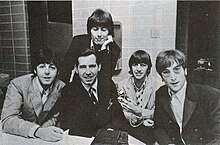The Beatles' 1966 US tour
The tour was plagued with backlash regarding the controversy of John Lennon's remark about the Beatles being "more popular than Jesus", death threats, and the band's own dissatisfaction with the noise levels and their ability to perform live.
Having already decided to retire from live performances at the end of the year, the 1966 US tour was the last series of commercial concerts undertaken by the Beatles.
[17] Led by WAQY in Birmingham, Alabama,[18] several radio stations there organised bonfires where listeners were invited to burn their Beatles records and merchandise, and programmers initiated a ban on the band's music.
[10] The publication of Paul McCartney's comment, from a 1 August radio interview, that Americans were obsessed with money furthered the mood of disquiet surrounding the Beatles.
[22][nb 2] In his press conference, Epstein said that he was prepared to cancel shows if any American promoter wished to back out, but that all the individuals were keen for the tour to go ahead.
[25] Early August was also marked by race riots in Atlanta, Chicago, Minneapolis, Omaha and Philadelphia, and by news of a killing spree in Texas carried out by Charles Whitman, a former US Marine.
[33] In the altered release schedules imposed by Capitol for North America, however, "Nowhere Man" and the Yesterday and Today track "If I Needed Someone" were also first issued in 1966,[34] having been part of the December 1965 LP Rubber Soul in other markets.
[37] Lennon stated that he was only commenting on the decline among churchgoers, that he made a mistake in using the Beatles' following in comparison with that of organised religion, and that he "never meant it as a lousy anti-religious thing".
[39] In a private meeting with Art Unger, Epstein asked him to surrender his press pass for the tour, to avoid accusations that Datebook and the Beatles' management had orchestrated the controversy as a publicity stunt.
[41] The apology placated many of those offended by the Datebook article; WAQY called off its Beatle bonfire, planned for 19 August,[42] and some stations lifted their radio bans.
[48] As they started to play "Day Tripper", over 2,000 fans broke through the security barriers separating the audience from the area housing the elevated stage,[49] causing the Beatles to stop the performance and shelter backstage.
[53] Around 100 private security personnel had been assigned to control the crowd of 45,000 fans,[54] 7,000 of whom broke through the fencing[55] and thwarted the band's exit in an armoured van.
[53] The Beatles remained trapped in a dressing room until, after two unsuccessful attempts to fool the crowd using decoy vehicles, they were able to escape with assistance from the local police.
[64] Having first voiced the group's opposition to the Vietnam War during their stay in Tokyo,[65][66] Lennon caused further controversy during the band's press conference in Toronto on 17 August when he stated his support for American draft-dodgers escaping to Canada.
Due to the reduced ticket sales and the expense of paying the Beatles their prearranged $50,000 performance fee, in addition to having to hire an orchestra to satisfy the local musicians union, the concert resulted in a loss for the company.
"[74] The first band member to tire of Beatlemania,[75] Harrison later said of the group's decision to quit touring: "We'd been through every race riot, and every city we went to there was some kind of a jam going on, and police control, and people threatening to do this and that ... and [us] being confined to a little room or a plane or a car.
"[76] Author Jonathan Gould comments on the significance of the Beatles ending their careers as live performers in San Francisco, since the city was the location for the first Human Be-In in January 1967.
[77] Typically of the era, newspaper coverage of the concerts focused on the size of the audiences, the volume of the fans' screams, and box office takings, rather than attempting to review each event or discuss the music.
[43] Throughout the tour, the US press seized on the opportunity to predict the end of Beatlemania and remarked on the absence of the usual crowds of screaming fans at the airports on their itinerary.
[80] The Beatles' ability to appeal to both sexes in this way helped codify a new youth movement in the US, which sought expression in student demonstrations at Berkeley from late 1966 onwards.
[77] The Beatles held a second successful concert at New York's Shea Stadium, following the world-record attendance they set there in August 1965, although ticket sales were down to 45,000, around 10,000 below the previous year.
[82] Author Nicholas Schaffner later wrote that although the numbers at Shea fell short of the 1965 total, the Beatles' ability to sell as many tickets as they did in 1966 was still "a feat nobody else at the time could have come near to duplicating".
[64][nb 5] On 28 August, the day of the band's penultimate concert, Epstein issued a press release in response to claims that some of the shows had been poorly attended: This tour compares phenomenally well with last year's.
By the time we leave, 400,000 people will have seen this series of shows ...[54]Lasting around 30 minutes, the Beatles' set list for the tour was as follows (lead singers appear in parentheses): Citations Bibliography

